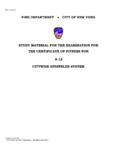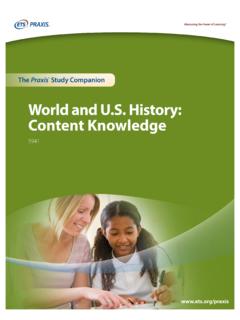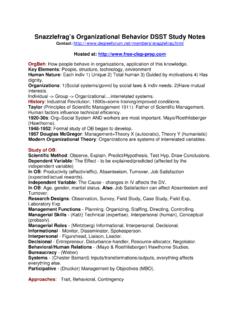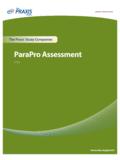Transcription of Enacting Glasser's (1998) Choice Theory in a grade 3 ...
1 Journal of Case Studies in Education Volume 7 January, 2015 Enacting Glasser's Choice , Page 1 Enacting Glasser's ( 1998 ) Choice Theory in a grade 3 classroom: a case study Jeff Irvine Brock University ABSTRACT Choice Theory identifies five psychological needs: survival, freedom, power, belonging, and fun ( glasser , 1998 ). There are close parallels with self- determination Theory (SDT), which specifies autonomy, competence, and relatedness as essential needs (Deci & Ryan, 2000). This case study examines a very successful example of Choice Theory enacted in a grade 3 class. Despite no training in either Choice Theory or SDT, the teacher blended all the dimensions of these theories to provide a supportive learning environment in which mutual trust was key. Keywords: glasser , Choice Theory , Theory to practice, self-determination Theory , case study Journal of Case Studies in Education Volume 7 January, 2015 Enacting Glasser's Choice , Page 2 Copyright statement: Authors retain the copyright to the manuscripts published in AABRI journals.
2 Please see the AABRI Copyright Policy at Journal of Case Studies in Education Volume 7 January, 2015 Enacting Glasser's Choice , Page 3 INTRODUCTION This paper will examine the enactment of Glasser's ( 1998 ) Choice Theory in a grade 3 classroom, using the methodology of a case study (Yin, 2009). Glasser's Choice Theory will be used as a framework, and supplementary discussion will be based on self-determination Theory (Deci & Ryan, 2000). This case is especially interesting because the teacher involved had no training in Choice Theory , and no knowledge of the principles or supporting research of Glasser's work. Choice Theory Glasser's ( 1998 ) Choice Theory identifies five basic needs that each person seeks to satisfy. These needs are survival, freedom, power, belonging, and fun. Sullo (2007) describes Glasser's work as "the most comprehensive, fully developed psychology of internal control" (p.)
3 8). Sullo continues that Choice Theory is " a biological Theory that suggests we are born with specific needs that we are genetically instructed to satisfy" (p. 8). The five needs are sometimes elaborated. For example, survival may be expanded to include safety and security, as well as psychological survival/nourishment. Power may be framed as competence, both actual and perceived, thus impacting self-efficacy, self-esteem, and peer perceptions. Freedom is usually associated with Choice . The Choice must be actual rather than illusory, and must not be forced or restricted, although the number of Choice options is important (Brooks & Young, 2011; Patall, Cooper, & Robinson, 2008; Schwartz, 2009). Patall et al. (2008) indicate that bounded Choice , free Choice with a limited number of options, is optimal.
4 Three to five options allows real Choice . Increasing the number of Choice options results in ego depletion (Patall et al., 2008; Schwartz, 2009), in which large numbers of options forces the chooser to spend inordinate amounts of time considering the options, shifting the focus to the Choice process and away from the quality of the options. An important tenet of Choice Theory is that each person acts intentionally to satisfy these needs. Therefore, every act is intentional, and every act is motivated to meet one or more of the five needs ( glasser , 1998 ). Like Sullo, the five needs are sometimes referred to as psychological needs or innate needs (Lloyd, 2005). Self-esteem (also referred to as self-concept, self-worth, self-image) is based on a person's thoughts, opinions, attitudes, and perceptions of self-efficacy, and is the basis for behaviors, including actions, interactions, and decision making (Zeeman, 2006).
5 This illustrates how difficult it is to tease out elements of Choice Theory . They are intertwined with concepts of self, with metacognition, goal setting and goal monitoring, engagement, empowerment, and agency. There are also links between Glasser's ( 1998 ) Choice Theory and Purkey's (as cited in Zeeman, 2006) invitational Theory . Zeeman points out that there are strong similarities between the two theories: "Essentially, both glasser and Purkey believe that we perceive the world looking for people or things that will satisfy what we want" (p. 47). Other researchers identify the importance of the social dimension in both learning and Choice Theory . Louis (2009) identifies the congruence of Choice Theory with Vygotsky. He lists three major propositions of Vygotskyan educational Theory as the Zone of Proximal Development, assistance given by a more knowledgeable person (scaffolding), and psychological tools.
6 The importance of social interaction enables scaffolding as well as the sharing of these psychological tools. To meet Glasser's five needs, social interaction is paramount. Louis outlines how the meeting of these needs might unfold in a classroom setting. Although, in my opinion, some of his suggestions Journal of Case Studies in Education Volume 7 January, 2015 Enacting Glasser's Choice , Page 4 could be significantly improved, he does point out that the accomplishment of these needs results in feelings of pleasure. Therefore, emotion is a major component of needs satisfaction (Louis, 2009), and thus emotion is a major component of learning (Sullo, 2007). Another closely related concept is self-determination Theory (SDT; Deci & Ryan, 2000). Self-determination Theory conceptualizes psychological needs as essential nutrients that are required for optimal psychological growth and well-being.
7 The needs for autonomy, competence and relatedness are thought to be universal across people and cultures and applicable throughout all aspects of a person's life. Autonomy refers to the experience of Choice and volition in one's behaviour and to the personal authentic endorsement of one's activities and actions. Competence involves the ability to bring about desired outcomes and feelings of effectiveness and mastery over one's environment. Finally, relatedness reflects feelings of closeness and connection on one's everyday interactions. (Milyavskaya & Koestner, 2011) There is a very close similarity between the two theories. Glasser's freedom need is reflected in SDT's autonomy. Belonging is very similar to relatedness, and power essentially identical to competence. Autonomy is identified as a major factor in intrinsic motivation (Deci, Vallerand, Pelletier, & Ryan, 1991; Milyavskaya & Koestner, 2011).
8 As with Choice Theory , SDT presumes that all behaviors are intentional or motivated (Deci et al., 1991). Autonomy has been identified as a significant element in student engagement (Jang, Reeve, & Deci, 2010), and, more generally, needs satisfaction is seen as critical to engagement as well (Lewis, Huebner, Malone, & Valois, 2011). Choice is a major factor in meeting the need for autonomy (freedom). For example, Gambrell (2011) lists Choice as one of seven factors leading to increased student engagement in reading. Several researchers have identified Choice as important for student motivation, and link Choice explicitly to SDT (Brooks & Young, 2011; Katz & Assor, 2007; Patall, 2012; Patall et al., 2008; Patall, Cooper, & Wynn, 2010; Schwarts, 2009). Katz and Assor subdivide choices into autonomy-enhancing choices, competency-enhancing choices, and relatedness-enhancing choices, and give instances of how teachers can provide such choices in the classroom.
9 They also point out (as do Brooks & Young, 2011; Schwartz, 2009) that the choices must be actual and not forced, and the number of choices must be bounded to avoid ego depletion. Schwartz identifies several studies that illustrate both the positive and negative effects of Choice , where the negative effects occur when the number of choices becomes unwieldy, or the Choice is not freely available, and the student is manipulated in some way to choose an option preferred by the instructor. Researchers have shown a direct causal link between Choice and intrinsic motivation (Patall et al., 2010), and between intrinsic motivation and academic performance (Deci et al., 1991). CASE STUDY This paper examines a holistic, single case study (Yin, 2009), with the unit of analysis one grade 3 class. The case examines diachronic covariation (Gerring, 2007) of student engagement, motivation, self-efficacy, and attitudes across one school year.
10 The research question was: Journal of Case Studies in Education Volume 7 January, 2015 Enacting Glasser's Choice , Page 5 How can a teacher use Choice Theory to support and enhance student engagement, intrinsic motivation, attitudes towards learning, and self-efficacy, by fostering ownership of learning? Propositions Teaching methods and activities that address student needs, as articulated in Choice Theory , will increase student engagement. Teaching methods and activities that address student needs, as articulated in Choice Theory , will increase intrinsic motivation, and thus student achievement. Teaching methods and activities that address student needs, as articulated in Choice Theory , will improve student attitudes towards learning, by increasing students' sense of ownership. Teaching methods and activities that address student needs, as articulated in Choice Theory , will improve student self-efficacy, by modifying the time constraint on learning, and shifting the focus to student accomplishment.















